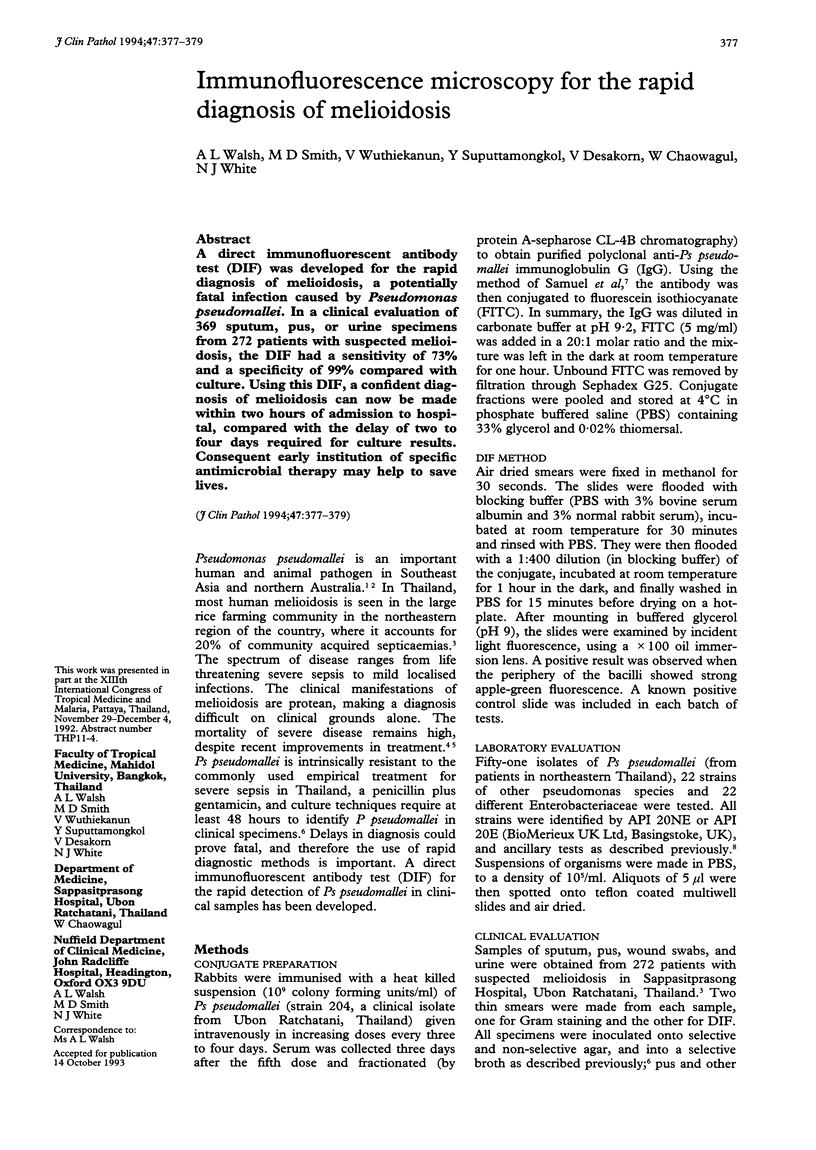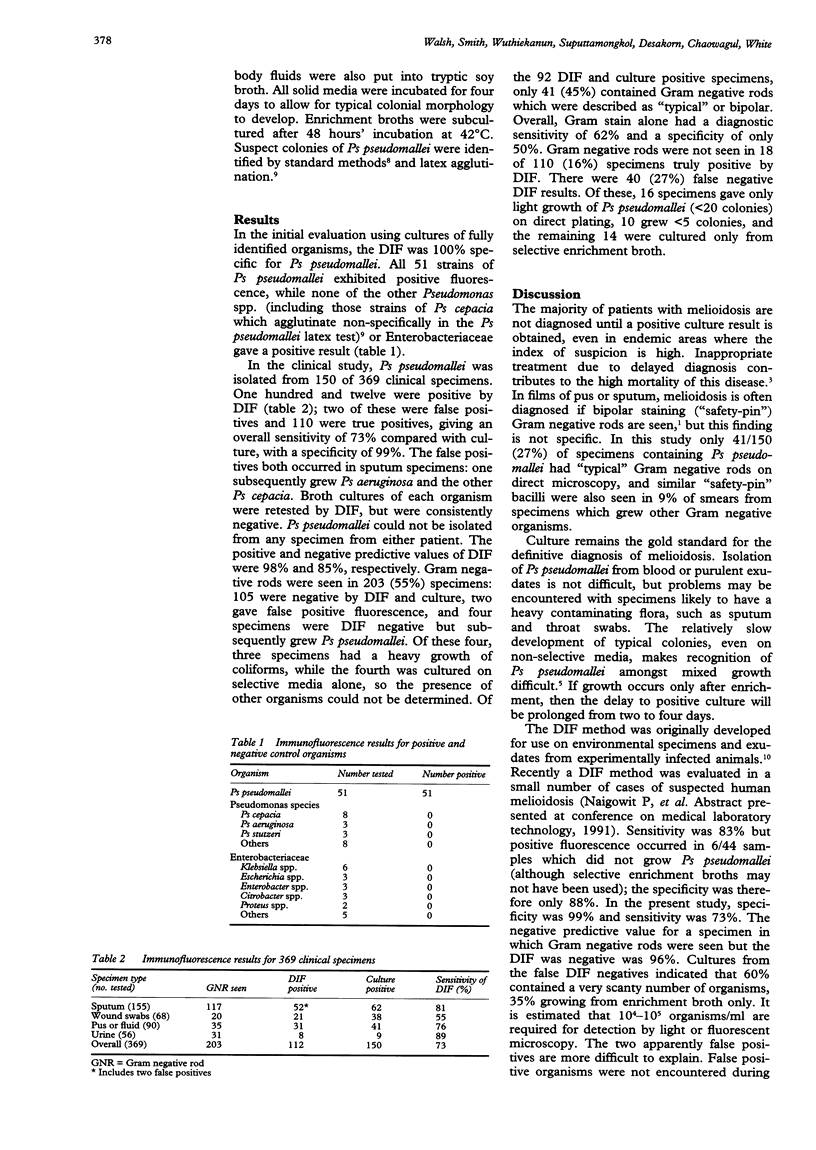Abstract
A direct immunofluorescent antibody test (DIF) was developed for the rapid diagnosis of melioidosis, a potentially fatal infection caused by Pseudomonas pseudomallei. In a clinical evaluation of 369 sputum, pus, or urine specimens from 272 patients with suspected melioidosis, the DIF had a sensitivity of 73% and a specificity of 99% compared with culture. Using this DIF, a confident diagnosis of melioidosis can now be made within two hours of admission to hospital, compared with the delay of two to four days required for culture results. Consequent early institution of specific antimicrobial therapy may help to save lives.
Full text
PDF


Selected References
These references are in PubMed. This may not be the complete list of references from this article.
- Chaowagul W., White N. J., Dance D. A., Wattanagoon Y., Naigowit P., Davis T. M., Looareesuwan S., Pitakwatchara N. Melioidosis: a major cause of community-acquired septicemia in northeastern Thailand. J Infect Dis. 1989 May;159(5):890–899. doi: 10.1093/infdis/159.5.890. [DOI] [PubMed] [Google Scholar]
- Dance D. A., Wuthiekanun V., Naigowit P., White N. J. Identification of Pseudomonas pseudomallei in clinical practice: use of simple screening tests and API 20NE. J Clin Pathol. 1989 Jun;42(6):645–648. doi: 10.1136/jcp.42.6.645. [DOI] [PMC free article] [PubMed] [Google Scholar]
- GOLDMAN M., MOODY M. D., THOMASON B. M. Staining bacterial smears with fluorescent antibody. II. Rapid detection of varying numbers of Malleomyces pseudomallei in contaminated materials and infected animals. J Bacteriol. 1956 Sep;72(3):362–367. doi: 10.1128/jb.72.3.362-367.1956. [DOI] [PMC free article] [PubMed] [Google Scholar]
- Kawamoto F. Rapid diagnosis of malaria by fluorescence microscopy with light microscope and interference filter. Lancet. 1991 Jan 26;337(8735):200–202. doi: 10.1016/0140-6736(91)92159-y. [DOI] [PubMed] [Google Scholar]
- Leelarasamee A., Bovornkitti S. Melioidosis: review and update. Rev Infect Dis. 1989 May-Jun;11(3):413–425. doi: 10.1093/clinids/11.3.413. [DOI] [PubMed] [Google Scholar]
- Samuel D., Patt R. J., Abuknesha R. A. A sensitive method of detecting proteins on dot and Western blots using a monoclonal antibody to FITC. J Immunol Methods. 1988 Mar 16;107(2):217–224. doi: 10.1016/0022-1759(88)90221-9. [DOI] [PubMed] [Google Scholar]
- Smith M. D., Wuthiekanun V., Walsh A. L., Pitt T. L. Latex agglutination test for identification of Pseudomonas pseudomallei. J Clin Pathol. 1993 Apr;46(4):374–375. doi: 10.1136/jcp.46.4.374. [DOI] [PMC free article] [PubMed] [Google Scholar]
- Sookpranee M., Boonma P., Susaengrat W., Bhuripanyo K., Punyagupta S. Multicenter prospective randomized trial comparing ceftazidime plus co-trimoxazole with chloramphenicol plus doxycycline and co-trimoxazole for treatment of severe melioidosis. Antimicrob Agents Chemother. 1992 Jan;36(1):158–162. doi: 10.1128/aac.36.1.158. [DOI] [PMC free article] [PubMed] [Google Scholar]
- White N. J., Dance D. A., Chaowagul W., Wattanagoon Y., Wuthiekanun V., Pitakwatchara N. Halving of mortality of severe melioidosis by ceftazidime. Lancet. 1989 Sep 23;2(8665):697–701. doi: 10.1016/s0140-6736(89)90768-x. [DOI] [PubMed] [Google Scholar]
- Wuthiekanun V., Dance D. A., Wattanagoon Y., Supputtamongkol Y., Chaowagul W., White N. J. The use of selective media for the isolation of Pseudomonas pseudomallei in clinical practice. J Med Microbiol. 1990 Oct;33(2):121–126. doi: 10.1099/00222615-33-2-121. [DOI] [PubMed] [Google Scholar]


